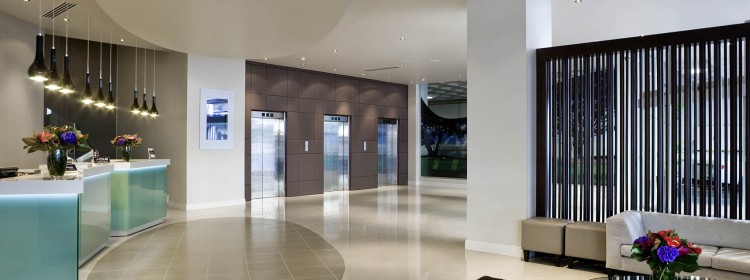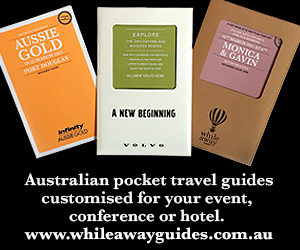On a grey-blue sea, ferries scuttle about in bright sunshine. A cruise liner looms at its mooring, while in the distance a low-cone-shaped sleeping volcano rises from the harbour – an unmistakable clue to the city I’ve recently arrived in.
This is the view from the eleventh-floor window of my room at AccorHotels’ 207-room Mercure Auckland Hotel, one of the most popular meeting and leisure destinations in the “Britomart” waterfront area of New Zealand’s biggest city.
 Recently refurbished and soon to be rebadged as a more upscale, four-and-a-half-star Grand Mercure, the hotel has eight naturally lit meeting rooms, set on a dedicated conference floor that can accommodate up to 200 theatre-style and has a banquet capacity of up to 150.
Recently refurbished and soon to be rebadged as a more upscale, four-and-a-half-star Grand Mercure, the hotel has eight naturally lit meeting rooms, set on a dedicated conference floor that can accommodate up to 200 theatre-style and has a banquet capacity of up to 150.
There are over 740 Mercure hotels around the world, but one of this one’s main attractions is its location, a hundred metres from Auckland’s ferry station and the pretty, sprawling harbour. It’s just a short walk from here, too, to the upscale bars and restaurants of the waterfront precinct and boat harbour, as well as some of the city’s key shopping areas.
“There are wonderful touring opportunities and access to activities right on our doorstep,” explains Georgina Grey (left), AccorHotels’ ebullient Director of Sales and Marketing for Auckland, Wellington and Christchurch.
“You can mix up a two- or three-day conference with offsite activities very effectively,” says Georgina, a former Qantas staffer based in New Zealand who’s been with AccorHotels for ten years. “That’s why we’re finding so many people coming here for conferences are staying on – it’s a really good value proposition for partners as well.”
The average conference group at the hotel is about fifty. “And when we need partners we work closely from an external point of view with The Cloud and Spark Arena, both multi-purpose events venues on the waterfront holding up to 6,000 people, and with the big Viaduct events centre which is an eight-minute walk from here as well,” she says.
The Mercure works closely, also, with the Pullman, one of AccorHotels’ five-star marques that has a capacity for 600 guests, banquet style, and 900 in theatre format. “We have 16 event spaces at the Pullman, and that’s just a five-minute walk up the hill from the waterfront.”
 Business, generally, is brisk for the AccorHotels business in Auckland, where the French multinational has ten hotels (including Sofitel, Novotel, Pullman and Ibis) and where Sofitel So, another luxury property, will be opening at the beginning of next year, says Georgina.
Business, generally, is brisk for the AccorHotels business in Auckland, where the French multinational has ten hotels (including Sofitel, Novotel, Pullman and Ibis) and where Sofitel So, another luxury property, will be opening at the beginning of next year, says Georgina.
Like the national economy, New Zealand visitor arrivals are surging. They reached 3.543 million in the year ended March, up 8.9% from a year earlier, according to Statistics New Zealand. Most of these people enter and leave via Auckland, where, The Siteseer discovered when visiting the city for the first time in a decade, the quality of dining and lodging today rivals that of the major Australian cities and where more and more people are attracted by the country’s spectacular scenery and perceived clean air and water.
“Auckland is now a destination in its own right, similar to Sydney but with some unique aspects,” says Georgina. “We compete with Australia and some parts of Asia but find that the ease of getting around here, the language and currency are big attractions – and of course getting to understand what jandals are [thongs]!”
It’s well-served by airlines and has, in particular, come on the radar of the American market, she adds. There’s fierce competition on the trans-Tasman route, with Chinese carriers coming in via Australia and Emirates flying-in A380s from Sydney and Melbourne. “We’re set on a beautiful harbour and apparently have the most boats per-capita of any city in the world,” says Georgina. “Apart from being a physically pleasing destination, it’s also a cost-effective one.”
 Further growth seems inevitable, with a plethora of construction cranes punctuating the skyline and the New Zealand International Convention centre due to come on stream in a couple of years’ time. “We’ll then be competing directly with Sydney, Melbourne and Brisbane for international business,” says Georgina.
Further growth seems inevitable, with a plethora of construction cranes punctuating the skyline and the New Zealand International Convention centre due to come on stream in a couple of years’ time. “We’ll then be competing directly with Sydney, Melbourne and Brisbane for international business,” says Georgina.
The soon to be rebranded Grand Mercure, whose refurbishment is nearing completion with the addition of Custom Lane, a café-by-day and bar-by-night facility on the ground floor adjacent to the lobby, will undoubtedly benefit. Meantime its conference clients can choose from a continually growing number of team-building and touring activities. For example, they can take a 35-minute ferry ride to beautiful Waiheke Island to sample some of the region’s wine, or enjoy a guided walk on Rangitoto Island, which last erupted around 600 years ago. The hotel provides walking routes, with maps, for guests which “really brings the outside in”.
Cycling is another option. The Siteseer took an easy, four-hour guided bicycle tour (USD70) that threaded its way through the waterfront area and then along the coast of Hauraki Gulf to the busy shopping and restaurant area of Mission Bay.
In the Britomart precinct around the Mercure, a variety of celebrity chefs have opened eateries in recent times, and many major retail brands, like Tiffany’s and Gucci, have set up shop. “In ten years this has gone from being an industrial bus-transport sort of area to a place conducive to a lovely night out,” says Georgina.
From USD200
Roughly, a day meeting package plus accommodation deals at the Auckland Mercure start from around USD200. That’s good value, says Georgina. Indeed this is a city in which, according to a recent report in the New Zealand Herald on Sunday, shortage of supply and pressure on hotels have forced organisers to use Airbnb for some of their clients.
More information here.






